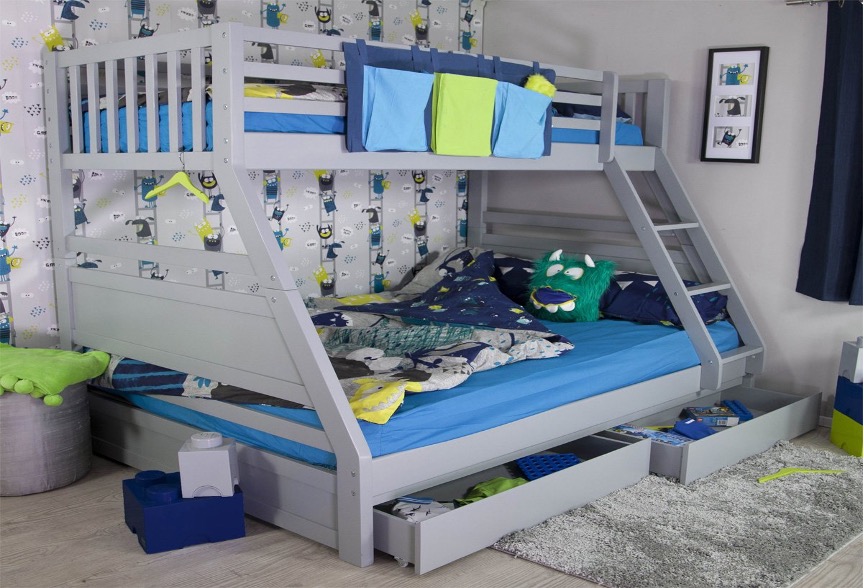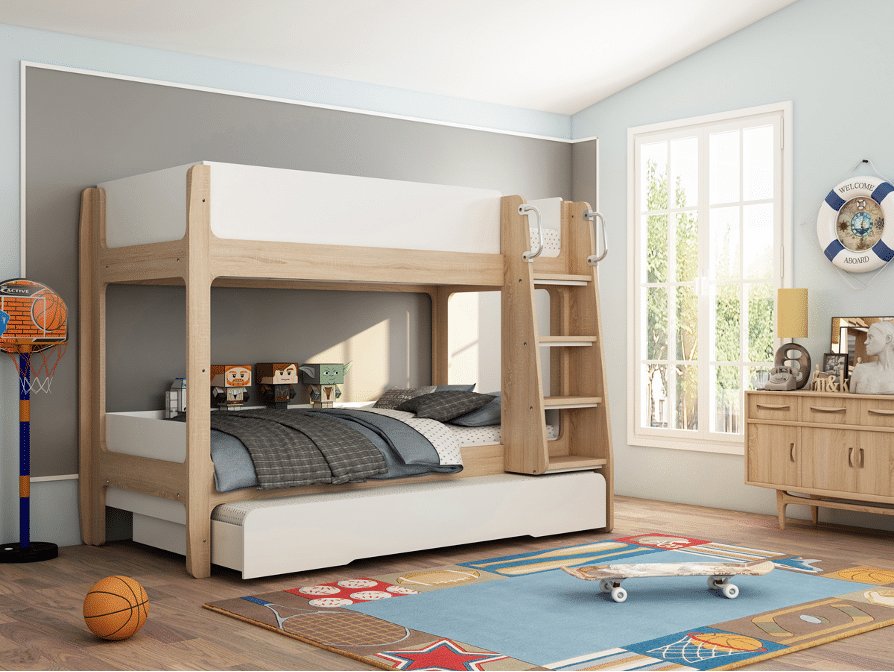
Bunk beds are one of the greatest home creations. Not only can they make a small house work for a growing family, but many kids also choose bunk beds over their bedroom because it’s fun to sleep with siblings. Bunk beds are cool!
Another great thing about bunk beds is the sheer variety available. You can get bunk beds for all room shapes and lifestyle requirements, from standard bunk beds (one up, one down) to bunk beds in an L shape.
There are also bunk beds without an extra bed. For instance, you can get bunk beds with a sofa under the top bunk and space for a computer desk and chair, making them a top choice for maximising space in small bedrooms.
To help you choose the right bunk beds, here’s a quick rundown of the different types of bunk beds you can buy.
Standard bunk beds

Pictured: Flair wooden bunk bed – grey, available online from Bedstar The Online Bed Superstore.
Standard bunk beds have a one-up-one-down configuration with two beds, with the frame made from either metal or wood or sometimes both. These bunk beds maximise floor space and are perfect for kids aged six and over.
Cot bed bunk beds
For young children and toddlers sharing a room, you can purchase cot bed bunk beds. These feature a cot bed bottom bunk suitable for children under 4, and children can usually use the top bunk over the age of 5.
Small double bunk beds
Small double bunk beds have a single bunk on top and a small double lower bunk.
The small double is ideal for older children.
Small double bunk beds take up more floor space but offer more bed space than standard bunk beds.
L-shaped bunk beds
L-shaped bunk beds can have a one-up-one-down or double top bunk configuration. L-shaped bunk beds are designed for room corners and can maximise space in bedrooms with a strange shape.
Triple bunk beds

Pictured: Flair ollie triple sleeper bunk bed – grey, available online from Bedstar The Online Bed Superstore.
Triple bunk beds require high ceilings because they stack three bunks on top of each other, but they are the best way to sleep three children in one room. You can also get L-shaped triple bunk beds in a two-up-one-below configuration.
Trundle bunk beds
Trundle bunk beds are ideal for sleepovers! While standard bunk beds require relatively high ceilings, trundle bunk beds sit lower to the ground and store an extra pull-out bed. The pull-out bed is a small single suitable for kids.

Pictured: Naples bunk bed with pull out trundle, available online from Bedstar The Online Bed Superstore.
Loft bunk bed
Loft bunk beds have a top bunk and a space underneath. The area can be used for anything, from a chest of drawers to a computer desk and chair. Loft bunk beds are perfect in very small bedrooms.
Study bunk beds
Study bunk beds have a standard top bunk and a built-in study below, usually comprising a desk, drawers and shelves. Study bunk beds are perfect for older children and teenagers but lose out on a bottom bunk for sleepovers.

Pictured: Julian Bowen Pegasus high sleeper with study area, available online from Bedstar The Online Bed Superstore.
Sofa bed bunk beds
Sofa bed bunk beds have a sofa bottom bunk that converts into a small double or single bed and a standard top bunk. These bunk beds are perfect when the bedroom user sleeps alone with only occasional spare bed use.
Treehouse bunk beds
The ultimate bed for children, treehouse bunk beds harness the magic of a playhouse to make bedtime special. However, while they promote a sense of adventure, treehouse bunk beds can make younger children a bit too giddy.
Bunk bed materials
Most bunk beds are made from wood or metal. Wood is preferred for younger children because it’s warm to the touch and soft. For older children, metal bunk beds are better for the simple reason they are more durable.
Aside from wood or metal, another consideration is colour. Grey bunk beds are a safe, neutral choice for every bedroom. White and natural finishes should be chosen based on the colour of other furniture in the bedroom.
Reserve bright colours for young children. Pinks, blues, reds, greens and purples are all good choices. Just be wary your children will grow out of them.


















Leave a Reply